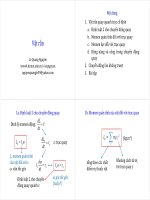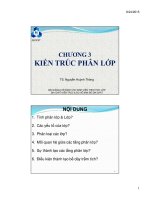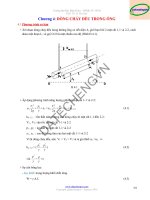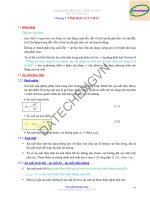Giao trinh bai tap 215004 chapter 1
Bạn đang xem bản rút gọn của tài liệu. Xem và tải ngay bản đầy đủ của tài liệu tại đây (494.2 KB, 8 trang )
Variability in Chemical Vapor Deposited Zinc Sulfide: Assessment of
Legacy and International CVD ZnS Materials
John McCloy,*a Ralph Korensteinb
a
Raytheon Missile Systems, 1151 E. Hermans Road, Tucson, AZ, USA 85734
b
Raytheon Company, 350 Lowell Street, Andover, MA, USA 01810
ABSTRACT
Samples of CVD ZnS from the United States, Germany, Israel, and China were evaluated using x-ray diffraction,
transmission and Raman spectroscopy, and biaxial flexure testing. Visible and near-infrared scattering, 6 μm
absorption, and ultraviolet cut-on edge varied substantially in tested materials. Transmission cut-on (ultraviolet edge)
blue-shifts with annealing and correlates with visible color but not the 6 μm absorption. Raman scattering for CVD
ZnS, presented here for the first time, was similar for all ZnS tested. Crystallographic hexagonality and texture was
determined and correlated qualitatively with optical scattering. All CVD ZnS tested with biaxial flexure exhibit similar
fracture strength values and Weibull moduli. This survey suggests that despite over 30 years of production as an
infrared window, the optical properties of CVD ZnS and their variability still defy easy explanation.
Keywords: Zinc sulfide, chemical vapor deposition, IR window
1. INTRODUCTION
Chemical vapor deposited (CVD) zinc sulfide has been an indispensable infrared window material since its introduction
in the early 1970s by Raytheon.1 Development of ZnS internationally has been recently documented2 but a comparison
of properties among various producers has not been previously available. Samples of CVD ZnS, Hot isostatic pressed
CVD ZnS (multispectral), some legacy experimental Raytheon grades (red ZnS and elemental ZnS), legacy hot-pressed
ZnS, and single crystal melt-grown ZnS were obtained from various suppliers. Transmission was investigated to study
scattering, absorption, and color. Several samples of red ZnS were annealed at various temperatures to investigate the
phenomenon of coloration in ZnS. X-ray diffraction (XRD) studies were used to quantitatively measure hexagonality
and crystallographic texture and investigate its relation to optical transmission. Finally, biaxial flexure testing was
performed, generating data sets for red ZnS and elemental ZnS not previously available.
2. EXPERIMENTAL
Various samples of ZnS were obtained for study as detailed in Table 1, including different suppliers of standard CVD
ZnS (made from hydrogen sulfide gas and zinc vapor), legacy Raytheon elemental ZnS (made from hydrogen gas,
sulfur, and zinc vapor3), legacy Raytheon red ZnS (grown ~600 °C with large excess of Zn reactant,4 and multi-spectral
ZnS (CVD ZnS which has been hot-isostatic pressed in the presence of platinum metal). Single crystal Bridgeman
grown crystals of ZnS and legacy hot-pressed ZnS from powder precursors were also studied.
Crystal structure was investigated using a Rigaku Geigerflex II x-ray diffractometer (XRD) fitted with a CuKα x-ray
source, a diffracted beam monochrometer, and a sodium iodide scintillation detector. Diffracted intensity of
polycrystalline samples was recorded for 2θ angles from 20 to 100º in 0.05º increments. Some samples were ground in
an agate bowl, and powder patterns were taken of the region between 25 and 35º with 0.02º resolution to further
investigate the characteristic region of ZnS polytypes.
*
Present address: Battelle Pacific Northwest National Laboratory,
Window and Dome Technologies and Materials XI, edited by Randal W. Tustison,
Proc. of SPIE Vol. 7302, 73020M · © 2009 SPIE · CCC code: 0277-786X/09/$18 · doi: 10.1117/12.819559
Proc. of SPIE Vol. 7302 73020M-1
Transmission of polished samples was investigated in the ultraviolet through near-infrared (175 – 3300 nm) on a Varian
Cary 5000 spectrophotometer, and data was recorded at 1 nm wavelength increments. Infrared transmission (2 – 20
μm) was measured using a Fourier transform infrared spectrometer, Bruker Equinox 55 FTIR, with a deuterated
triglycine sulfate (DTGS) detector using a spectral resolution of 4 cm-1 and signal averaging over 80 scans.
Raman spectroscopy was performed using a Thermo-Nicolet Almega XR single beam dispersive spectrometer with a
holographic notch filter to block the 532 nm laser excitation beam. Samples were placed under the 10x objective of the
confocal microscope. Spectral resolution was 2.2 – 2.5 cm-1 with the high resolution grating, 25 μm slit, and 79 to 1290
cm-1 spectral range. Laser power was 13% and spectra were averaged over 32 scans. A few ZnS samples were also
surveyed with the low resolution grating out to 4248 cm-1, with spectral resolution 6.4 – 10.5 cm-1.
Biaxial flexure strength testing was performed in accordance with ASTM C1499.5 The characteristic diameters were as
follows: 10.67 mm (load ring), 20.32 mm (support ring), and 25.4 mm (sample). Sample thickness was 1.9 to 2.0 mm.
All samples had the CVD growth axis perpendicular to the plane of the large area of the sample which was placed under
stress. Various samples were tested, with some datasets having more data points than others due to sample availability.
All sample surfaces were polished using a controlled grind procedure to minimize the effects of the surface flaw
population differences, using successive steps of grinding and polishing with smaller grits.
Table 1: ZnS samples investigated; all polycrystalline unless otherwise noted
Nomenclature
Material type
Supplier
Bridgeman
IRTRAN
RH
II-VI
Raytran
PS
Melt grown crystal ZnS
Hot pressed powder ZnS
Standard CVD
Standard CVD
Standard CVD
Standard CVD
Vitron
Rafael CVD
RedZnS
Standard CVD
Standard CVD
CVD
MTI
Kodak
Rohm & Haas
II-VI Infrared
Raytheon
Princeton Scientific
(US) importer
Vitron
Rafael
Raytheon
eZnS
PS msZnS
CVD
(H2 + S + Zn)
CVD
(H2 + S + Zn)
CVD + (Pt?) HIP
PS HH
CVD + (Pt?) HIP
Vitron msZnS
Vitron HH
Rafael msZnS
Ray msZnS, msZnS
CVD + Pt HIP
CVD + HIP (no Pt)
CVD + HIP (no Pt)
CVD + Pt HIP
Chinese
Country of
Origin
USA
USA
USA
USA
USA
Germany
Germany
Israel
USA
Notes
(110) plane
various material lots
Raytheon
USA
“FLIR grade”
“FLIR grade”
~600 °C deposition,
very Zn rich reactant;
“elemental ZnS”
Research institute
synthetic crystals
Princeton Scientific
(US) importer
Princeton Scientific
(US) importer
Vitron
Vitron
Rafael
Raytheon
China
See Reference 6
Germany
“multispectral ZnS”
Germany
special short HIP
(unknown details)
“clear grade”
“special clear grade”
“multispectral ZnS”
“multispectral ZnS”
Germany
Germany
Israel
USA
3. RESULTS
3.1 Atomic structure
Diffraction patterns of polycrystalline samples were taken from 2θ angles 20 – 100°. Some of these are shown
normalized to their maximum peak in Figure 1a. Generally, the texture of as-deposited CVD samples including eZnS is
Proc. of SPIE Vol. 7302 73020M-2
predominantly {100} while that of HIPped samples is predominantly {111} , presumably due to plastic deformation and
recrystallization. Nucleation and growth rates are highest on “atomically rough” planes which have higher densities of
kinks and steps, like {100} planes, and would be expected to dominate as-deposited materials,7 though it should be
noted that RedZnS had a significantly higher fraction of {111} . A quantitative analysis of the texture was performed
using the scattered intensities for textured planes (hkl) in the polycrystalline sample (txt superscript), calculated as8
(
)(
txt
txt
iso
iso
f hkl = I hkl
/ ∑ I hkl
/ I hkl
/ ∑ I hkl
)
(1)
In an isotropic polycrystalline sample fhkl=1 for all (hkl) planes. The larger the value, the larger the volume fraction
of {hkl} planes orientated in the Bragg diffraction position. The powder pattern for cubic ZnS #05-0566 was used as
the “isotropic” sample (iso superscript). Furthermore, the % {111} and % {100} was calculated as follows (Figure 1b):
f
+ f 222,msZnS 1.60 + 1.46
(2)
=
= 0.5 = 50%
%{111}msZnS = 111,msZnS
6.18
∑ f hkl ,msZnS
a)
b)
066)
:6
H
((C)
((9)
666)
(006)
(000)
660)
06t6)
- -
5O
msZnS
8
4O
6
RafmsZnS
Red
30
S
9
S
x
(0)
/ 9-i
'isotropic' (randomly oriented)
0
S
6
Sd
20
IRTRAN
Various CVD ZnS
10%
1
H
eZnS
1
0
00
06
06
9
09
09
06
OL
06
o
OOI
10%
0%
20
40%
30
5O
6O
(100) texture (°)
c)
0.1
d)
Specific sample
Rayth
sZnS
Rafae rzrs
Oht (%)
3%
%
13106.4 cm1)
a A)
1104
5.411
:
5 41
1
Vtrn o Pt HI
13%
1126
RLI
CH nee
2 3%
1 6%
-
54111
22
414
4
54:4
EIemnt
32%
:
5411
'IIVI
Ef3%
202
5.410
Rafae CVD
E 5%
251
5 112
IRTRArJ2
26%
6
Brdçjen-in
S 7%
:
':'
5411
0.08 -
0
0.06-
0.04 E
0
z
0.02 -
0
26
27
28
29
30
31
20
Figure 1 X-ray diffraction data for ZnS samples; (a, UL) normalized polycrystalline diffraction data; (b, UR)
quantification of textures, with various CVD ZnS samples in dotted box; (c, LL) hexagonality, calculated
extinction, and lattice parameter; (d, LR) XRD powder pattern from which hexagonality data was calculated
Lattice parameter measurements were made, using a NIST traceable alumina standard internal to the instrument, using
the alumina (0.2.10) plane reflection (expected at 2θ = 88.995° and measured at 89.02°) to perform the angular
correction. Diffracted intensity was measured from 87.7 to 89.3° for ZnS at 0.02° intervals with 5 second integration
time. The sphalerite (422) reflection, measured at 2θ = 88.4 to 88.6°, was corrected by the standard, then used to
calculate the interplanar spacing (dhkl) and the cubic lattice parameter.9 The estimated accuracy of lattice constant
measurements is better than ±0.001 Å. Measured lattice parameters are shown in Figure 1c.
Proc. of SPIE Vol. 7302 73020M-3
A simple measure of the hexagonality in polycrystalline ZnS powders and hot-pressed compacts has been proposed
using the ratios of characteristic peaks in the wurtzite and sphalerite XRD spectra.10-12 The atomic fraction of
hexagonal stacking (hexagonality) can be calculated as
{w (0002) + s (111)}
I 28.53
⎛
α hex = 1.84 ⎜⎜ 1 −
⎝
{w (0002) + s (111)}
I 28.53
+I
w (10 10)
26.91
⎞
⎟⎟
⎠
(3)
where w is the 2H hexagonal phase (wurtzite), s is the 3C cubic phase (sphalerite), the subscripts are 2θ angles, and the
superscripts are the characteristic planes, since the 2H(0002) and the 3C(111) overlap at 2θ=28.53°. Intensity values
were obtained using the peak height of the higher resolution, smaller angular range data. Representative data is shown
in Figure 1c and 1d for HIPped ZnS (msZnS, similar spectra for all HIPped samples in this study), eZnS (similar spectra
for Chinese and red), CVD ZnS (Raytran, similar for all standard CVD samples in this study), and Bridgeman meltgrown crystal. Note the extra peaks (~29.6˚ and 30.1˚) for the Bridgeman crystal, which can be most closely indexed by
assuming a 72R polytype structure (even though the crystals were sold as 3C pure cubic crystals).
3.2 Optical properties
Composite spectra of FTIR and UV-VIS transmission measurements for various samples are shown in Figure 2.
Sample thicknesses, UV edge (defined as the last spectrometer data point on the short wavelength edge of the
transparency window before a negative transmission value was recorded), and transmission and calculated extinction for
various wavelengths and samples are shown in Table 2. Extinction is calculated from measured transmission as:
(4)
β ext = (1 / L ) * ln ⎡ (1 − R ) 2 / 2T + R 2 + (1 − R ) 4 / 4T 2 ⎤
⎣
⎦
-1
where β is the extinction coefficient (in cm ), L is the sample thickness, T is the measured transmittance, and R is the
single surface reflectivity in air calculated from the index of refraction (from the Sellmeier equation for CVD ZnS3).
Table 2: Measured transmittance, UV edge, and calculated extinction (cm-1) at key wavelengths; 1.064,
3.39, and 10.6 μm are laser wavelengths and 6 μm gives an indication of the zinc hydride absorption.
Errors on the calculated extinction are larger for thinner samples.
Theoretical (no
scatter, phonon abs)
Raytheon Elemental
Raytheon Red
Chinese
Vitron FLIR
Rohm & Haas
Rafael CVD
II-VI Infrared
Princeton Scientific
FLIR
Kodak IRTRAN2
Raytheon
Multispectral
Bridgeman single
crystal
T1.064/ α1.064
T3.39/ α3.39
T6.0/ α6.0
T10.6/ α10.6
340
n = 2.288
73.5%
n = 2.255
74.1%
n = 2.240
74.5%
n = 2.192
75.5%
4.64
3.18
4.62
2.00
4.64
2.49
4.89
5.13
386
400
386
380
382
361
383
390
55.3% / 0.59
67.0% / 0.27
62.1% / 0.35
28.7% / 4.59
16.9% / 3.11
50.9% / 1.42
26.8% / 2.02
8.4% / 4.18
72.9% / 0.03
72.2% / 0.08
71.8% / 0.07
68.5% / 0.38
56.9% / 0.55
65.9% / 0.45
61.0% / 0.38
54.3% / 0.59
59.6% / 0.46
48.1% / 1.33
73.1% / 0.04
62.8% / 0.82
60.8% / 0.42
70.4% / 0.22
60.9% / 0.40
50.9% / 0.72
68.7% / 0.14
67.9% / 0.32
68.4% / 0.21
72.5% / 0.20
68.4% / 0.21
70.8% / 0.25
64.8% / 0.30
64.7% / 0.29
6.39
4.64
445
344
1.1% / 6.54
72.0% / 0.04
63.3% / 0.24
73.6% / 0.01
71.3% / 0.06
74.4% / <0.01
60.5% / 0.34
69.2% / 0.18
1.00
340
73.1% / 0.04
72.8% / 0.17
73.2% / 0.16
73.3% / 0.29
Thickness
(mm)
UV edge
(nm)
n/a
Proc. of SPIE Vol. 7302 73020M-4
60
60
60
60
C
C
0
0
.8 40
E
E
=
=
20
20
6
6
14
12
10
16
10
WaveIegth (icro)
12
16
14
WaveIegth (ioror)
Figure 2: Transmission graphs for some of the measured ZnS samples, thicknesses as in Table 1. (1)
Ray msZnS, (2) RedZnS, (3) eZnS, (4) Rohm & Haas, (5) IRTRAN, (6) Chinese, (7) Tmax, which is the
calculated transmission (from refractive index) with only reflection losses (Ref 3)
A series of samples of red ZnS were subjected to vacuum anneal treatments from 650 to 850 °C in a Seco/Warwick
furnace. It was initially assumed that annealing would enable hydrogen release13 and show a change in the
characteristic 6 μm absorption. Since red ZnS had the strongest and most well-defined absorption here, it seemed the
right candidate to explore. Secondly, there was some anecdotal evidence that red ZnS visible transmission changed
differently under annealing conditions than CVD ZnS did. There was a desire to explore this aspect as well, since red
ZnS had the longest wavelength ultraviolet edge of any of the samples tested.
Typical thicknesses of untreated standard yellow CVD ZnS had a UV edge of 382 nm which blue-shifted to 343-344 nm
when annealed (in vacuum at 850 °C for 24 hours) or HIPped. In contrast to HIPing, annealing of CVD ZnS in general
produced markedly more scattering in the visible and near-infrared, despite blue-shifting band edge. This ultraviolet
transmission improvement with heat treatment is believed to be due to the removal of band gap electronic defects
involving impurities of oxygen14 and/ or hydrogen.13
a)
b)
0.8 -
650C
650C
No
24h
2h
treatment
/
440
460
I if i,'
0.6
(0
(0
E
0.4 C,
I0.2 -
340
360
380
400
420
480
0
2
4
6
8
10
12
14
16
Wavelength (microns)
Wavelength (nanometers)
Figure 3: (a,L) UV-VIS edge of Red ZnS annealing experiments; (b,R) IR transmission of annealed Red
Figure 3 shows a summary of the transmission measurements for these annealing experiments along with photographs
of some of the samples before and after the heat treatment. Starting samples were all approximately 3.175 mm thick.
One sample was subjected to a 650 °C anneal for successively small amounts of time, first 2 hours, and then an
additional 4 hours for a total of 6 hours. After the first 2 hours, very little if any change was evident in the infrared but
the UV band edge blue-shifted slightly. The apparently slightly higher long-wave transmission in this sample is due to
Proc. of SPIE Vol. 7302 73020M-5
slight tilt or wedge. After the next 4 hours of annealing, again there was very little change in the infrared with the 6 μm
absorption remaining deep, sharp, and two pronged, with no significant spectral or intensity change. Visible
transmission degraded and the band edge further blue-shifted. Another red sample was subjected to high temperature
for a short time, 850 °C for 2 hours, resulting in a complete elimination of the 6 μm absorption, a large scattering from
the visible through the infrared, and a band edge blue-shift despite strong scattering.
0
0
0,
a
(0
0
0
0
0)
(0
0
-J
0
00
0
a
145: 2TA(L)
97: aflidentifled
219: T0(X)-TA(X)
-181: 2TAQ()
--
400: T0(X)-C-TAQ()
425: L(X)TQ()
446: L0(L)TA(L)
619 210(X)
642 LO(L)4-TO(L)
--61: 2 LqQ()
I
Scattered intensity (Arb. Un.)
I
a, t. 00 00 -
350: LO(1)
The most striking change in these samples was their change in visual appearance (color and transparency). Samples
with a reddish hue have band edges around 400 to 420 nm, absorbing the violet most strongly and hence appearing red.
By way of comparison, standard ZnS which is yellowish typically has a band edge of around 375 nm which transmits
all the visible to some extent but transmission in the violet is low. In the latter case described (850 °C anneal), the
reddish-yellow color was eliminated and the sample became whitish yellow and highly scattering. In the other case
(650 °C anneal), the first 2 hour anneal changed the sample from reddish to orangish, with the edges of the disk being
more effected than the bulk. The subsequent 4 hour anneal changed the sample to a colorless material which was still
fairly low scatter despite the reduced transmission from the band edge to about 3 μm. This is interesting since the color
in the sample is gone but the 6 μm absorption generally associated with zinc hydride remains. Most authors have
claimed an intimate relationship between the hydride absorption and the color of ZnS (e.g. Lewis et al.13). An etched
microstructure was taken of the 650 °C sample after 6 hours annealing which revealed no recrystallization and minimal
if any grain size coarsening.
Figure 4: Raman scattering data in CVD ZnS
Raman scattering was also performed on the samples
as no data was available in the literature on Raman of
CVD ZnS.
Almost all the samples were
indistinguishable in the Raman spectrum from 85 to
1290 cm-1. The main peaks were indexed using a
combination of sources.15, 16 Given the similarity of
most of the Raman spectra, only a few representative
ones are shown in Figure 4. A few minor differences
among ZnS samples were noted. Red ZnS showed an
unidentified peak at 97 cm-1 which was present in no
other samples except possibly one of spectra taken of
the Bridgman crystal. The annealed red ZnS sample
no longer showed this peak and looked more like the
other ZnS samples at the low wave number shifts.
Raytheon multispectral ZnS had a weak broad band
centered at 1098 cm-1 which was not evident in other
ZnS samples.
3.3 Biaxial flexure testing
Seven sets of samples were tested and Weibull analysis was performed as described in previous publications.17 A
simple T-test was used to see if the mean fracture strengths were alike or different. The results are shown in Table 3
where the samples, their designations, and the number of samples is as follows: Rohm & Haas CVD ZnS (RH, 20);
RedZnS (Red, 23); elemental ZnS (E, 26); Raytheon multispectral HIPped ZnS (MS, 7); Princeton Scientific
multispectral HIPped ZnS (PS HH, 6); Princeton Scientific CVD FLIR grade (PS, 6); and II-VI CVD ZnS (II-VI, 26).
Boxes with a red “x” indicate that the row versus column T-test (two-tailed distribution, two-sample unequal variance)
are statistically different. The matrix is symmetric, so the other half of the matrix shows the actual calculated values.
This analysis basically shows that the samples can be grouped into three categories based on the mean strength (values
shown in Table 4). The strongest samples were the II-VI standard CVD ZnS samples (group 1). Statistically lower
strength as-deposited CVD samples (group 2) included the yellow standard commercial CVD grades produced by Rohm
& Haas (RH) and Princeton Scientific (PS), as well as elemental ZnS (E) and Red ZnS (Red). Lowest in strength
(group 3) were the HIPped samples processed using the normal high temperature HIP process of commercial
multispectral ZnS (MS and PS HH datasets).
Proc. of SPIE Vol. 7302 73020M-6
A Weibull analysis was performed using the maximum likelihood estimate (MLE) method as described in ASTM
C1239.18 A summary of the parameters determined from this analysis are also shown in Table 4. The strengths were
normalized to 1 cm2 stressed area based on the effective tensile stressed area (ASTM C1499 eq. X1.3). For this
analysis, the Poisson’s ratio for the HIPped samples was assumed to be 0.32 and that of the CVD samples was assumed
to be 0.29 per Klein and Willingham19. The biased Weibull modulus does not take into account the number of
specimens while the unbiased one does and is therefore more conservative. These values agree well with previous
published Weibull numbers,20 when all the data is normalized correctly.
The CVD materials all have a moderate Weibull modulus and higher scale factor than the heat treated samples. All tests
were done on the same apparatus with the same surface preparation by the same optical shop, so surface flaws should be
similar for all samples. However, the different Young’s modulus between as-deposited and HIPped samples, could
influence the behavior of abrasives interacting with the sample and result in a different flaw size in the CVD versus
HIPped materials.
Table 3: T-test matrix on biaxial flexure strength data of ZnS samples; matrix is symmetric so actual
values are shown on the bottom half and statistically “different” (X) or “not different” (O) on the top
AS
RH
I
J 27Y1
E
J
a ooi
X
X
J
X
H
X
X
0
0
X
X
0
0
x
x
34508
OB253
L C)O0
C
:.00000
L
JJLC
0.214
:i 14cJo
o 33674
a "4231
0.00182
1.IiJ57
= (Th351
:ooi
ES HH
=
Il-vi
HH
F
C'
''
Lc-
X
X
0
.c:c'7i
i.11f
'.c::''
=
Table 4: ZnS biaxial flexure results. Mean and standard deviation is shown for actual samples.
Weibull scale factor is normalized to 1cm2 stressed areas as described in Reference 17
effective
tensile
Avg grain
Group
Designation
size
(microns
N
1
ritrScentt
E
Ement3
sec)
59
39
Rohm & Ha
2
3
rIs
3
SHH
193
6
4
DVD
VD
26
22
2"'
''D
2:
:2 El
H
Mean
Strength SD (MPa)
(FiPo
L4
VD
rrutspotri 5h
rr1ct3r1Sc HfHed
stressed
area
iii m2
L
-
2
2
2
Sample Description
-231
:j4
11 1
541
21
4
2398
511
240
20.4
Weibull
rIodulus
(unbiased
Weibull
Modulus
biased)
221
621
91
101
655
scale
factor
ripa)
psi)
41
L4f5
4 22
14'4
213'S
662
?5
1'O45
16432
1135
51
482
Weibull
scale
factor
1.
414
44b
269
159
164
deubull
:'
b4
52
11
945'
4. DISCUSSION
In assessing x-ray diffraction data, optical transmittance, and strength, CVD ZnS samples can be grouped into three
categories. The first is the standard CVD materials, including Raytran, IIVI, RH, Rafael, and Vitron. Measured
hexagonality is 5 – 10 % and extinction at 1064 nm is 1.5 – 6.6 cm-1. The second group includes the more transparent
as-deposited samples, including redZnS, Chinese ZnS, and elemental ZnS. Measured hexagonality is 2 – 5% and
extinction at 1064 nm is 0.3 – 0.7 cm-1. The third group includes the HIPped samples, including msZnS, Rafael msZnS,
Vitron msZnS, PS msZnS, and PS HH. Measured hexagonality is <1% and extinction at 1064 nm is 0.03 to 0.26cm-1.
Biaxial strength is essentially the same for all the as-deposited CVD ZnS (groups 1 and 2) with the possible exception
of IIVI which appears to be slightly stronger. Some notable differences remain to be explained. Particularly, the 6 μm
absorption is considerably different within the above categories above (e.g. RafZnS has small α6.0 while other CVD ZnS
have large α6.0, and Chinese ZnS has small α6.0 while elemental and red ZnS have large α6.0). Hot pressed ZnS and
Bridgeman crystals are, as expected, considerably different from CVD ZnS. It is clear that there are still some propertyprocessing relationships that remain to be elicited in the understanding of CVD and HIPped CVD ZnS.
Proc. of SPIE Vol. 7302 73020M-7
Acknowledgements
Thanks to those who supplied samples of their ZnS material for testing including Stephen Jacobs of the University of
Rochester for the Chinese ZnS, Klaus Wöhner of Vitron in Germany, and Shay Joseph of Rafael in Israel. Todd
Stefanik and C. Scott Nordahl at Raytheon performed some of the polycrystalline x-ray measurements. Thanks to Brian
Zelinski, W. Howard Poisl, and Gavin Buttigieg for valuable discussions. Also thanks to Patrick Hogan who
participated in the early parts of this work.
REFERENCES
[1] Harris, D.C., "History of the development of hot-pressed and chemical-vapor-deposited zinc sulfide and zinc
selenide in the United States," Proc. SPIE 6545, 654502 (2007).
[2] McCloy, J., "International development of chemical vapor deposited zinc sulfide," Proc. SPIE 6545, 654503 (2007).
[3] Harris, D.C., Materials for Infrared Windows and Domes: Properties and Performance. SPIE Press, Bellingham,
WA (1999).
[4] diBenedetto, B.A. and J. Pappis, "Chemical Vapor Deposition of Multispectral Domes," Technical Report AFMLTR-75-27, (1975).
[5] ASTM, "Standard Test Method for Monotonic Equibiaxial Flexural Strength of Advanced Ceramics at Ambient
Temperature," ASTM-C1499-05, (2005).
[6] Fang, Z., et al., "CVD growth of bulk polycrystalline ZnS and its optical properties," Journal of Crystal Growth,
237-239, 1707-1710 (2002).
[7] Shchurov, A.F., et al., "Structure and Mechanical Properties of Polycrystalline Zinc Sulfide," Inorganic Materials,
40(2), 96-101 (2004).
[8] McCloy, J., "Properties and Processing of Chemical Vapor Deposited Zinc Sulfide," Ph.D.Dissertation, University
of Arizona, Department of Materials Science and Engineering, (2008).
[9] Cullity, B.D. and S.R. Stock, Elements of X-ray Diffraction. 3rd ed., Prentice Hall, 2001).
[10] Bansagi, T., et al., "Kinetics of hexagonal-cubic phase transformation of zinc sulfide in vacuo, in zinc vapor, and in
sulfur vapor," Canadian Journal of Chemistry, 46(18), 2881-2886 (1968).
[11] Xue, L.A. and R. Raj, "Superplastic deformation of zinc sulfide near its transformation temperature (1020 °C),"
Journal of the American Ceramic Society, 72(10), 1792-1796 (1989).
[12] Xue, L.A. and R. Raj, "Effect of hot-pressing temperature on the optical transmission of zinc sulfide," Applied
Physics Letters, 58(5), 441-43 (1991).
[13] Lewis, K.L., G.S. Arthur, and S.A. Banyard, "Hydrogen-related Defects in Vapour-Deposited Zinc Sulphide,"
Journal of Crystal Growth, 66, 125-136 (1984).
[14] Kroeger, F.A. and J.A.M. Dikhoff, "The Function of Oxygen in Zinc Sulfide Phosphors," Journal of the
Electrochemical Society, 99(4), 144-154 (1952).
[15] Klein, C.A. and R.N. Donadio, "Infrared-active phonons in cubic zinc sulfide," Journal of Applied Physics, 51(1),
797-800 (1980).
[16] Serrano, J., et al., "Raman scattering in beta-ZnS," Physical Review B, 69, 014301-1 to 04301-11 (2004).
[17] Huie, J., C. Dudding, and J. McCloy, "Polycrystalline Yttrium Aluminum Garnet (YAG) for IR Transparent
Missile Domes and Windows," Proc. SPIE 6545, 65450E (2007).
[18] ASTM, "Standard Practice for Reporting Uniaxial Strength Data and Estimating Weibull Distribution Parameters
for Advanced Ceramics," ASTM-C1239-06, (2006).
[19] Klein, C.A. and C.B. Willingham, "Elastic properties of chemically vapor-deposited ZnS and ZnSe," in Basic
Properties of Optical Materials, NBS Special Publication Washington, DC, 137-140 (1985).
[20] Klein, C.A., R.P. Miller, and R.L. Gentilman, "Characteristic strength and Weibull modulus of selected infraredtransmitting materials," Optical Engineering, 41(2), 3151-3160 (2002).
Proc. of SPIE Vol. 7302 73020M-8









